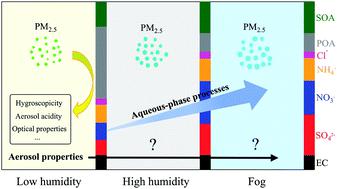当前位置:
X-MOL 学术
›
Faraday Discuss.
›
论文详情
Our official English website, www.x-mol.net, welcomes your
feedback! (Note: you will need to create a separate account there.)
Multiphase chemistry experiment in Fogs and Aerosols in the North China Plain (McFAN): integrated analysis and intensive winter campaign 2018
Faraday Discussions ( IF 3.3 ) Pub Date : 2020-10-5 , DOI: 10.1039/d0fd00099j Guo Li 1 , Hang Su , Nan Ma , Jiangchuan Tao , Ye Kuang , Qiaoqiao Wang , Juan Hong , Yuxuan Zhang , Uwe Kuhn , Shaobin Zhang , Xihao Pan , Nan Lu , Min Tang , Guangjie Zheng , Zhibin Wang , Yang Gao , Peng Cheng , Wanyun Xu , Guangsheng Zhou , Chunsheng Zhao , Bin Yuan , Min Shao , Aijun Ding , Qiang Zhang , Pingqing Fu , Yele Sun , Ulrich Pöschl , Yafang Cheng
Faraday Discussions ( IF 3.3 ) Pub Date : 2020-10-5 , DOI: 10.1039/d0fd00099j Guo Li 1 , Hang Su , Nan Ma , Jiangchuan Tao , Ye Kuang , Qiaoqiao Wang , Juan Hong , Yuxuan Zhang , Uwe Kuhn , Shaobin Zhang , Xihao Pan , Nan Lu , Min Tang , Guangjie Zheng , Zhibin Wang , Yang Gao , Peng Cheng , Wanyun Xu , Guangsheng Zhou , Chunsheng Zhao , Bin Yuan , Min Shao , Aijun Ding , Qiang Zhang , Pingqing Fu , Yele Sun , Ulrich Pöschl , Yafang Cheng
Affiliation

|
Fine-particle pollution associated with winter haze threatens the health of more than 400 million people in the North China Plain. The Multiphase chemistry experiment in Fogs and Aerosols in the North China Plain (McFAN) investigated the physicochemical mechanisms leading to haze formation with a focus on the contributions of multiphase processes in aerosols and fogs. We integrated observations on multiple platforms with regional and box model simulations to identify and characterize the key oxidation processes producing sulfate, nitrate and secondary organic aerosols. An outdoor twin-chamber system was deployed to conduct kinetic experiments under real atmospheric conditions in comparison to literature kinetic data from laboratory studies. The experiments were spanning multiple years since 2017 and an intensive field campaign was performed in the winter of 2018. The location of the site minimizes fast transition between clean and polluted air masses, and regimes representative for the North China Plain were observed at the measurement location in Gucheng near Beijing. The consecutive multi-year experiments document recent trends of PM2.5 pollution and corresponding changes of aerosol physical and chemical properties, enabling in-depth investigations of established and newly proposed chemical mechanisms of haze formation. This study is mainly focusing on the data obtained from the winter campaign 2018. To investigate multiphase chemistry, the results are presented and discussed by means of three characteristic cases: low humidity, high humidity and fog. We find a strong relative humidity dependence of aerosol chemical compositions, suggesting an important role of multiphase chemistry. Compared with the low humidity period, both PM1 and PM2.5 show higher mass fraction of secondary inorganic aerosols (SIA, mainly as nitrate, sulfate and ammonium) and secondary organic aerosols (SOA) during high humidity and fog episodes. The changes in aerosol composition further influence aerosol physical properties, e.g., with higher aerosol hygroscopicity parameter κ and single scattering albedo SSA under high humidity and fog cases. The campaign-averaged aerosol pH is 5.1 ± 0.9, of which the variation is mainly driven by the aerosol water content (AWC) concentrations. Overall, the McFAN experiment provides new evidence of the key role of multiphase reactions in regulating aerosol chemical composition and physical properties in polluted regions.
更新日期:2020-12-09











































 京公网安备 11010802027423号
京公网安备 11010802027423号